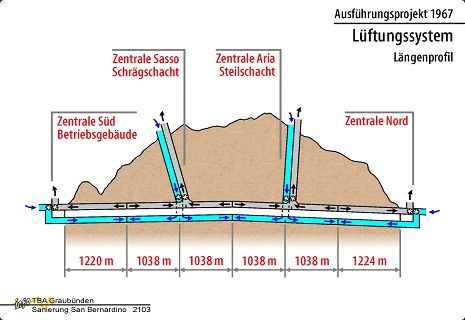Description
Owing to its favourable geographical location, the road across the San Bernardino pass has been one of the preferred trading routes between northern Italy and southern Germany since ancient times. It therefore comes as no surprise that as early as the 1930s there was talk of building a tunnel, which would provide a north-south link that would be usable even in winter. In the Swiss federal road network the San Bernardino road and its continuation towards Lake Constance is listed as the N13. In 1961 the Swiss federal council approved a project to construct a tunnel between the villages of Hinterrhein and San Bernardino. Work on the tunnel began in August 1961. To build the tunnel and niches, some 550,000 m3 of rock were excavated. The tunnel road is a category 2 and 3 national road, main stretches of which have only one lane in each direction (without physical separating barrier).
Tunnel
- Length: 6,596 km
- Elevation at tunnel mouths: 1,600 m above sea level.
- Lane width: 7.50 m
- Footways on either side: 0.73 m wide each
- Cross-section of road tunnel: 40 m2
- curve radius = 400 m at the tunnel mouths
- curve radius = 2,000 m at one-third and at two-thirds of total length
- SOS bays: every 250 m.
Near both tunnel mouths the N13 was connected to the existing pass road and the villages of Hinterrhein and San Bernardino by a grade-separated road.
Figure, from left to right
In black
Implementation project 1967
Ventilation system
Longitudinal profile
In red
Ventilation centre South
Operations building
Ventilation centre Sasso
Near-vertical shaft
Ventilation centre Aria
Vertical shaft
Ventilation centre North

